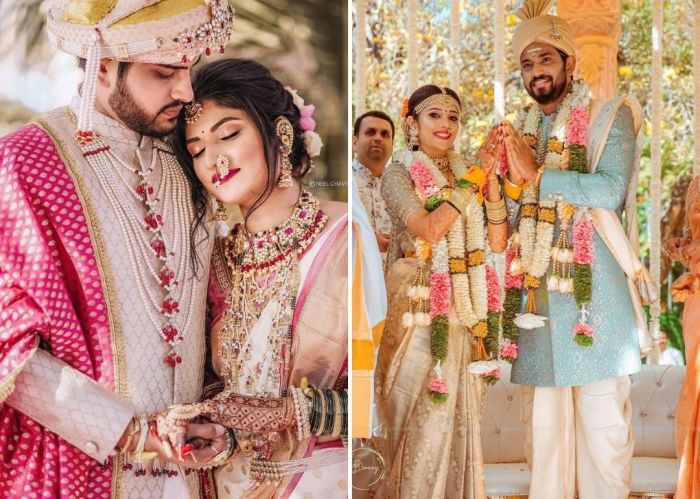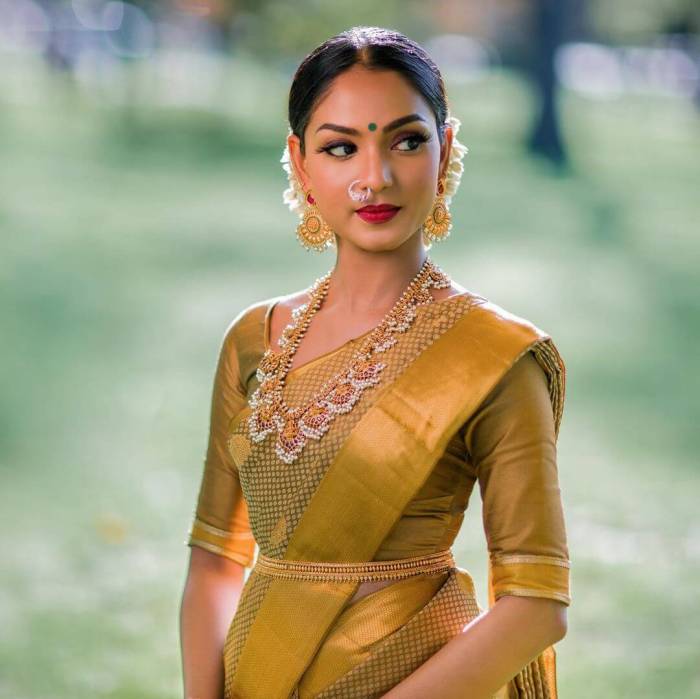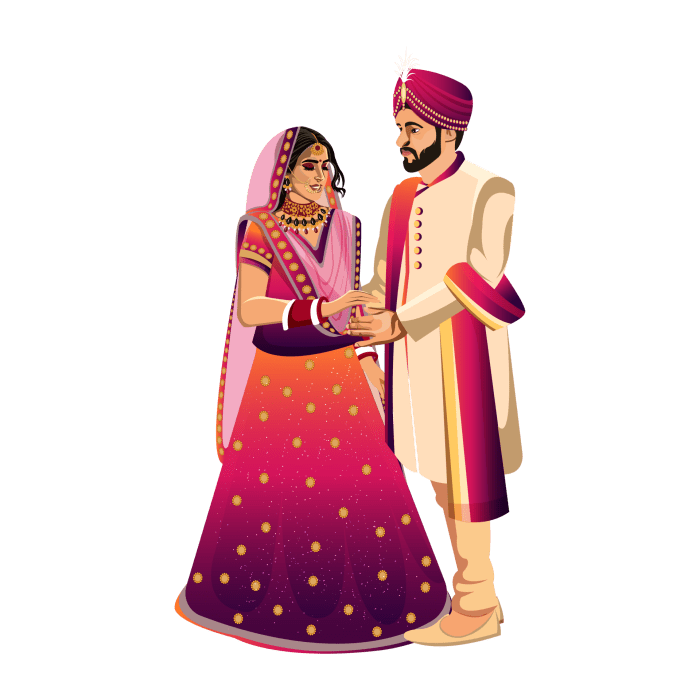Types of South Indian Wedding Dresses

Source: shaadiwish.com
South indian wedding dress – South Indian wedding attire is renowned for its vibrant colors, rich fabrics, and intricate craftsmanship. The choice of saree, its draping style, and accompanying jewelry vary significantly across different regions and communities. This section explores the diverse types of South Indian wedding sarees, their unique features, and regional variations.
South Indian Wedding Saree Types and Draping Styles
Several types of sarees are traditionally worn at South Indian weddings, each with its distinct characteristics and draping style. The most popular include Kanjeevaram, Banarasi, and various regional silks. The draping style, often influenced by regional customs, further enhances the saree’s elegance and beauty.
| Saree Type | Draping Style | Region of Origin | Distinguishing Features |
|---|---|---|---|
| Kanjeevaram | Nivi style, often with a pallu draped over the shoulder | Kanchipuram, Tamil Nadu | Heavy silk, intricate zari work, bold colors |
| Banarasi | Nivi style, sometimes with a more contemporary drape | Varanasi, Uttar Pradesh (though worn in South India) | Fine silk, intricate brocade work, often gold and pastel colors |
| Mysore Silk | Nivi style, sometimes with a pleated pallu | Mysore, Karnataka | Soft silk, subtle zari work, often featuring traditional motifs |
| Kerala Kasavu | Traditional Kerala style, often with a plain pallu | Kerala | Cream-colored cotton or silk, gold zari borders, simple yet elegant |
Traditional Jewelry with South Indian Sarees
The choice of jewelry complements the saree and reflects the bride’s regional heritage and personal style. Specific jewelry pieces are traditionally associated with each saree type, enhancing the overall look.
- Kanjeevaram Saree: Heavy gold necklaces (kasu mala, haram), bangles (gold, bangles with stones), earrings (jhumkas, long earrings), waist belt (oddiyanam), and a maang tikka.
- Banarasi Saree: A mix of gold and precious stone jewelry, delicate necklaces, earrings (kundan, jhumkas), bangles, and a maang tikka. The style can be more elaborate or simpler depending on the saree’s design.
- Mysore Silk Saree: Elegant gold jewelry, delicate necklaces, simple earrings, bangles, and a small maang tikka. The focus is often on understated elegance.
- Kerala Kasavu Saree: Simple gold jewelry, traditional Kerala temple jewelry, and often minimal adornment, focusing on the elegance of the saree itself.
Fabrics and Colors in South Indian Wedding Attire
The fabrics and colors chosen for South Indian wedding attire hold deep cultural significance, often symbolizing prosperity, fertility, and good fortune. This section explores the traditional fabrics, their cultural importance, and the symbolism behind popular wedding colors.
Significance of Traditional Fabrics
Silk and cotton are the most prevalent fabrics in South Indian wedding attire. Silk, particularly, symbolizes luxury, richness, and auspiciousness. Cotton, while less common for the main saree, is used for underskirts and other garments, representing comfort and purity.
Symbolism of Colors in South Indian Weddings
| Color | Symbolism | Regional Prevalence | Examples of Use |
|---|---|---|---|
| Red | Prosperity, fertility, good fortune | Widespread across South India | Kanjeevaram sarees, blouses |
| Gold | Wealth, prosperity, divinity | Widespread across South India | Zari work on sarees, jewelry |
| Green | Fertility, new beginnings | More prevalent in certain regions | Accent colors in sarees, blouses |
| Yellow | Joy, optimism | Common in certain regions | Blouses, accessories |
Regional Variations in Color and Fabric, South indian wedding dress
While certain colors and fabrics are common across South India, regional variations exist. For instance, Kerala often features cream-colored Kasavu sarees, while Tamil Nadu is known for its vibrant Kanjeevaram silks. Karnataka showcases a range of silk sarees with varying colors and designs.
Modern Interpretations of Traditional South Indian Wedding Dresses
Contemporary designers are creatively reinterpreting traditional South Indian wedding attire, blending modern aesthetics with timeless elegance. This section explores three modern variations of a traditional Kanjeevaram saree and discusses the impact of modern fashion trends on traditional designs.
Modern Kanjeevaram Saree Variations
The following are three modern interpretations of the classic Kanjeevaram saree, demonstrating how traditional elements can be updated for a contemporary bride.
- Design 1: A pastel-colored Kanjeevaram saree with subtle zari work, paired with a modern, fitted blouse. The fabric is a lighter silk, offering a more comfortable feel for the modern bride. The color palette is muted, perhaps a soft pink or mint green, retaining the elegance of the traditional saree while offering a contemporary twist.
- Design 2: A Kanjeevaram saree with a contemporary drape, showcasing a unique pallu design. The saree incorporates a bold color scheme, perhaps a combination of deep blues and gold. The blouse could feature a modern cut and unique embellishments.
- Design 3: A Kanjeevaram saree with unconventional embellishments. Instead of traditional zari, it might feature contemporary embroidery or appliqué work. The fabric might be a silk blend, adding a unique texture and drape. The color could be a rich jewel tone, like emerald green or sapphire blue.
Contemporary Design Choices and Fashion Trends

Source: shaadiwish.com
Modern designers are incorporating elements like asymmetrical drapes, unique blouse designs, and unconventional embellishments, while retaining the rich heritage of traditional South Indian sarees. The use of unconventional color palettes and fabric blends also contributes to the modern interpretation of traditional attire.
Accessories and Adornments
Traditional South Indian bridal jewelry and hairstyles are integral parts of the wedding attire, carrying deep cultural and symbolic meaning. This section explores the various types of jewelry, a traditional hairstyle, and regional variations in accessories.
Traditional South Indian Bridal Jewelry

Source: vecteezy.com
South Indian bridal jewelry is known for its intricate designs and use of gold and precious stones. Each piece holds significance, often representing prosperity, fertility, and protection.
- Necklaces: Kasu mala (coin necklaces), haram (long necklaces), and choker necklaces, often adorned with precious stones.
- Earrings: Jhumkas (bell-shaped earrings), long earrings, and stud earrings, often featuring intricate designs.
- Bangles: Gold bangles, bangles with precious stones, and kada (rigid bangles).
- Waist Belt (Oddiyanam): A decorative belt worn around the waist, often made of gold.
- Maang Tikka: A forehead ornament that adorns the parting of the hair.
- Bindi: A decorative dot worn on the forehead, often embellished with jewels.
Traditional South Indian Bridal Hairstyle
A traditional South Indian bridal hairstyle typically involves intricate braiding, buns, and the use of flowers and hair accessories. The specific style may vary based on regional customs and personal preferences. A common style involves creating a neat bun adorned with flowers, hairpins, and jewelry.
Regional Variations in Accessories
| Accessory | Region | Significance | Materials |
|---|---|---|---|
| Temple Jewelry | South India (widely) | Represents divinity and auspiciousness | Gold, precious stones |
| Kasu Mala | Tamil Nadu | Symbolizes prosperity and wealth | Gold coins |
| Jhumkas | Across South India | Adds elegance and grace | Gold, precious stones |
Illustrative Examples of South Indian Wedding Dresses
This section presents detailed descriptions of three distinct South Indian wedding dresses, highlighting their unique features and cultural significance. Each description emphasizes the fabric, color, embellishments, and overall style.
Detailed Descriptions of South Indian Wedding Dresses
The following descriptions showcase the diversity within South Indian bridal attire.
- Dress 1: A vibrant red Kanjeevaram silk saree with intricate gold zari work depicting traditional motifs. The saree is draped in the Nivi style, with a pleated pallu draped over the shoulder. The accompanying jewelry includes a heavy gold necklace, jhumkas, bangles, and a maang tikka. The blouse is a traditional, fitted style in a contrasting color.
- Dress 2: A cream-colored Kerala Kasavu saree with gold zari borders. The saree is draped in the traditional Kerala style, with a simple, elegant drape. The jewelry is minimal, featuring traditional Kerala temple jewelry pieces. The blouse is a simple, elegant style, complementing the simplicity of the saree.
- Dress 3: A Mysore silk saree in a deep teal color with subtle gold zari work. The saree is draped in the Nivi style, with a pleated pallu. The jewelry is a mix of gold and precious stones, featuring a delicate necklace, earrings, bangles, and a maang tikka. The blouse is a modern, fitted style that complements the saree’s color and design.
Illustrative Descriptions of South Indian Wedding Dress Designs
These descriptions emphasize the visual elements and cultural significance of the designs.
- Illustration 1: Depicts a Kanjeevaram saree in a rich crimson red, with intricate gold zari work forming floral patterns. The texture of the silk is shown to be luxurious and heavy. The saree is draped elegantly, and the model wears traditional South Indian jewelry.
- Illustration 2: Shows a Kerala Kasavu saree in a soft ivory color, with delicate gold zari borders. The texture of the cotton or silk is shown to be smooth and flowing. The saree is draped in a simpler style, reflecting the understated elegance of the Kerala tradition. The model wears minimal jewelry, highlighting the saree’s beauty.
- Illustration 3: Illustrates a Mysore silk saree in a deep emerald green, with subtle gold zari detailing. The texture of the silk is shown to be soft and lustrous. The saree is draped in a more contemporary style, blending tradition with modern aesthetics. The model wears elegant jewelry, complementing the saree’s color and design.
Quick FAQs
What is the average cost of a South Indian wedding saree?
The cost varies greatly depending on the fabric (silk, cotton, etc.), embellishments, and brand. Prices can range from a few hundred dollars to several thousand.
South Indian wedding dresses are renowned for their vibrant colors and intricate embroidery. The luxurious fabrics often used, such as Kanjeevaram silk, lend themselves beautifully to the rich textures found in many silk and satin wedding dresses , showcasing the elegance of these materials. This preference for high-quality textiles underscores the importance of tradition and craftsmanship in South Indian bridal attire.
How long does it take to drape a South Indian wedding saree?
The time required depends on the complexity of the draping style and the individual’s experience. It can range from 30 minutes to over an hour.
Can I wear a South Indian wedding saree for a non-wedding event?
Absolutely! Many South Indian sarees are versatile enough for various formal occasions, such as festivals or celebrations.
Where can I find authentic South Indian wedding sarees?
You can find them at specialized Indian clothing stores, online retailers, or directly from weavers in South India.
